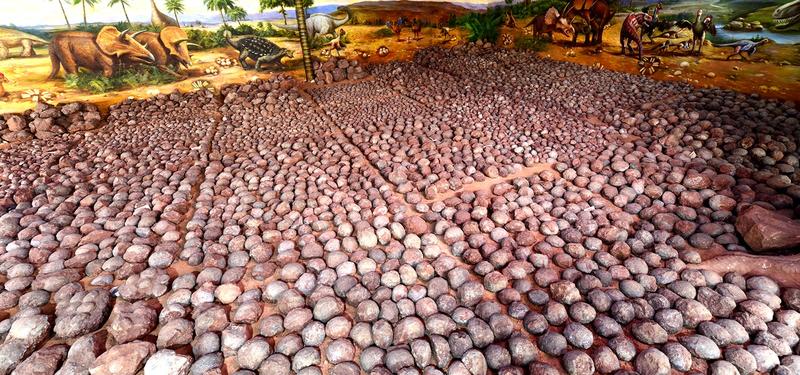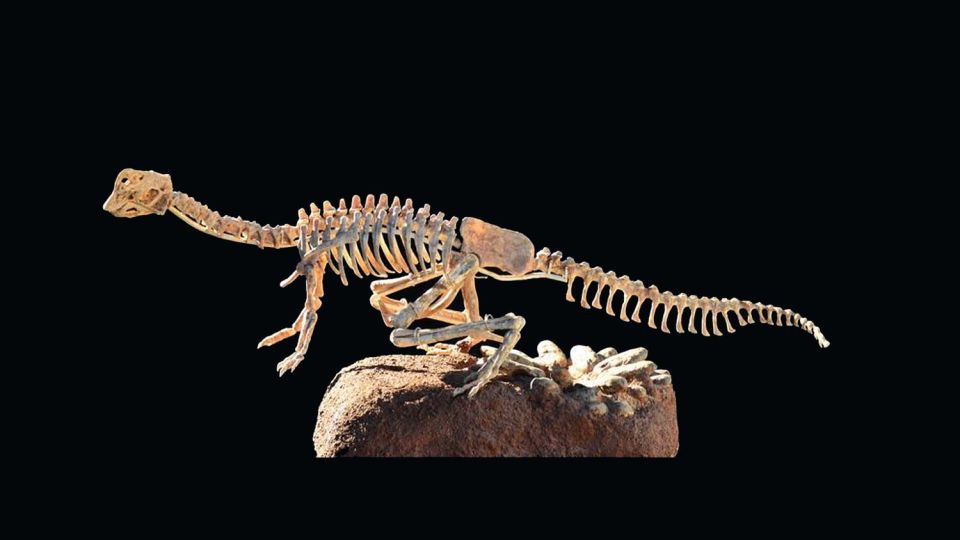October 6, 2022
HEYUAN – It took nearly three years for workers at a dinosaur museum in Heyuan, Guangdong province to restore a nest of 11 dinosaur eggs unearthed near a local bridge.
“Every piece of information about the dinosaur eggs is well recorded, waiting for future uncovering,” said Huang Zhiqing, deputy director of the collection and research department at the Heyuan Dinosaur Museum.
The nest of eggs is just a small part of their kind in the museum. There are nearly 20,000 dinosaur egg fossils on display at the museum since the first dinosaur egg fossil was dug up in Heyuan in 1996.
In November 2004, the museum won the Guinness World Record for keeping 10,008 dinosaur eggs, the largest number in a collection around the world.
“Repairing a nest of dinosaur eggs, including fine carving and polishing, usually involves a group of workers taking several months to three years to complete the process,” said Huang, who has been engaged in field investigation and fossil restoration research for 25 years.
The nest of eleven fossil eggs was discovered by primary student Zhang Yangzhe, who was playing with his mother near a broken bridge spanning the Dongjiang River on July 23, 2019. Parts of the bridge had been washed away by a flood.
Repairing a nest of dinosaur eggs requires patience, perseverance and a meticulous approach by workers.
Huang Zhiqing, deputy director of the collection and research department at the Heyuan Dinosaur Museum

Dinosaur egg fossils restored in 2022. (PHOTO PROVIDED TO CHINA DAILY)
They accidentally found the eggs in exposed soil at the fractured bridge foundation on the river bank, which were later brought back to a repair workshop of the Heyuan Dinosaur Museum.
“We had to carry out a long, meticulous, rigorous and scientific repair work on those egg fossils,” Huang said.
The eggs were embedded in red sandstone and some of them ended up being broken after the sandstone was crushed during deep excavation and rescue, according to Huang.
“Repairing a nest of dinosaur eggs requires patience, perseverance and a meticulous approach by workers,” he said.
Workers had to rely on hammers, steel chisels and high-carbon steel needles to carve and polish the eggs due to a lack of funds in that early stage of work. Conditions later improved after sophisticated tools such as geological hammers and imported pneumatic guns were introduced.
“Like dentists, workers here were carving and polishing the eggs in a very meticulous way, slowly exposing the fossils from the red sandstone body more accurately and gradually picking out the historical information of the dinosaurs,” he said.

A nest of dinosaur egg fossils restored in 2022. (PHOTO PROVIDED TO CHINA DAILY)
It usually took at least one month to repair a single round egg fossil with a diameter of about 6 centimeters, and about four years for three workers in the museum to repair six large nests of such eggs, said Huang.
“It is not all about quantity. Quality and scientific attitude also matter in the process of repairing dinosaur eggs,” he added.
After scientific identification, the nest of 11 eggs belongs to the late Cretaceous Period, some 90 million years ago, said Wang Qiang, associate researcher of the Institute of Vertebrate Paleontology and Paleoanthropology of the Chinese Academy of Sciences.
Heyuan, one of the few places in the world where dinosaur eggs, bones and footprints have been discovered, is home to at least five dinosaur species, according to Wang.
“Dinosaur eggs found in Heyuan are famous for their large quantity and diverse variety,” he said.

People visit the Heyuan Dinosaur Museum in August. (HUANG ZANFU / FOR CHINA DAILY)
In the coastal province of Guangdong, dinosaur eggs have also been found in Nanxiong, Huizhou and Foshan in the Pearl River Delta region and Maoming in the western part of the province.
Dinosaur eggs found in Guangdong date back to both the earliest and late stages of the Cretaceous Period, said Wang.
“Dinosaur eggs unearthed in other areas are generally of a single type. From the perspective of geological age, eggs discovered in Heyuan play a connecting role in the dinosaur egg fossil group in China,” he said.
Unlike fossils usually found in soft soil elsewhere, dinosaur eggs in Heyuan are mainly found in rough red sandstone, added Wang.
Among all the areas in China where dinosaur eggs were found, Heyuan is the only place where dinosaurs had laid their eggs in rough “delivery rooms”, according to Wang.
“It provides more possibilities for future research on the living environment of dinosaurs in Heyuan, and also reflects the adaptability of these dinosaurs to the environment,” he said.

Footprints of dinosaur found on a mountain near the museum. (HUANG ZANFU / FOR CHINA DAILY
Research found that those dinosaurs did not lay their eggs at the place where they lived. And that explained why there are “dinosaurs found without eggs” and “eggs found without dinosaurs” in some places, Wang added.
More scientific research on dinosaur eggs is needed in the future in the sense that there have been no embryos found inside the eggs so far unearthed in Heyuan, he said.
“Comprehensive research should be conducted to promote better understanding of the egg fossils,” Wang said. Of more than 1,000 dinosaur species named worldwide, 300 were discovered in China.
Dinosaur eggs in the Heyuan Dinosaur Museum will help provide a detailed physical basis for scientific research on Guangdong’s geological environment and biodiversity in the future, said Du Yanli, director of the museum.
The fossilized eggs are various in terms of length, size and shape, with specifications ranging from 1.5 cm to 23 cm, which are of great scientific value, he said.
The museum has established a relatively complete database of the dinosaur eggs so far discovered in Heyuan, according to Du.
“The size, weight, location and soil horizon of each egg are clearly recorded. They are more like a string of encrypted symbols, waiting for decoding in the future,” he said.

Dinosaur egg fossils displayed at the museum, which holds a Guinness World Record for keeping 10,008 such eggs. (HUANG ZANFU / FOR CHINA DAILY)
Dinosaur egg fossils turn out to be a rich source of information about the diversity and paleogeographic distribution of dinosaurs in Guangdong during the late Cretaceous Period. They also help provide favorable conditions for the study of ancient topography and geomorphology in the province, Du said.
“Different from other paleontological fossils, dinosaur eggs are the main carriers of reproduction information, playing an important role in breeding new life,” he said.
Local authorities in Heyuan initiated a plan to establish a joint research institute to promote geological studies on dinosaurs and the area, Du said.
“The research institute, which will give full play to the dinosaur eggs found in Heyuan as favorable resources, is also aimed at tapping the potentials of development and utilization of dinosaur culture,” he said.
The institute, featuring studies on dinosaur eggs, will be jointly set up by the Heyuan Dinosaur Museum, the Institute of Vertebrate Paleontology of the Chinese Academy of Sciences, Jilin University and Sun Yat-sen University, which is based in Guangzhou, capital of Guangdong.
Scientific research and systematic analysis of ancient geography, especially of the environment of areas where dinosaur eggs were found, will offer a glimpse into the natural world, said Du.
The institute, the first of its kind in South China, will help train more professional talents in scientific research and also serve as a platform for technical cooperation in studying fossilized dinosaur eggs in the region, according to Du.
“We will make more efforts to uncover the mysteries about various dinosaurs and their evolutionary process,” he said.
However, it is difficult to estimate the total number of fossilized dinosaur remains, which may be buried in the 100 square kilometers of red sandstones on both sides of the Dongjiang River, Du said.
Sporadic dinosaur egg fossils have also been unearthed in Dongyuan, Heping and other places of Heyuan. There are also 168 dinosaur footprints in eight groups found in the city’s urban areas.


